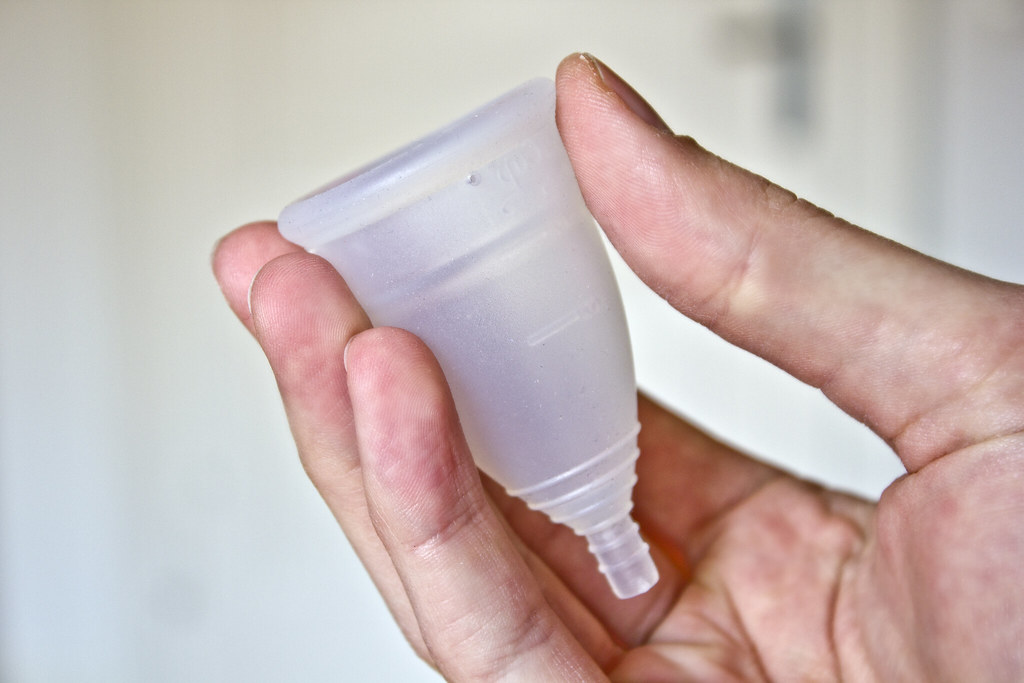Let's not sugarcoat this: periods suck. So whenever I hear about a way to make that time of the month suck a little less, I'm more than willing to try it. To that end, despite some skepticism, I tried using a menstrual cup. One year later, I still use my cup and have nothing but good things to say about it. It's convenient, it's cheap, and it's better for both me and the environment. They aren't for everybody, but here's some info about menstrual cups to help you decide for yourself
What Is a Menstrual Cup?

menstruationstasse.net on Flickr
Menstrual cups are small, flexible cups of silicone or rubber that sit relatively low in the vaginal canal (no more than half an inch in). Like with tampons, if your menstrual cup is properly inserted, you won't feel it at all. However, unlike tampons, menstrual cups are reusable and are designed to catch your period blood, rather than absorb it. Once every twelve hours or fewer, they must be removed, emptied, cleaned, and reinserted.
Benefits of Menstrual Cups
1. They're less expensive
Menstrual cups generally cost anywhere from $20 to $40, depending on the brand. This is more expensive up front than a box of pads or tampons, but a menstrual cup can last for several years if properly cared for.
Let's compare that to how much money you may be spending on tampons, which are the most popular option among college-aged women. Women spend an average of $1,773.33 on tampons over their lifetimes, or $46.67 in a year. So even if your menstrual cup only lasts you a year – and remember, it should work for several – you'll still be saving money, getting you one little step closer to swimming in money like Beyoncé.
They're better for the environment

Whether you use tampons, pads, or some combination of the two, you ultimately throw away your feminine products – not to mention their packaging and applicators. Using a menstrual cup can save as much as 250 to 300 pounds of waste in a lifetime.
(If you're not comfortable with using a menstrual cup but are concerned for the environment, try non-applicator tampons like o.b.)
They don't have to be changed as often

menstruationstasse.net on Flickr
Menstrual cups only have to be changed every ten to twelve hours (or slightly more often on the heaviest days of your flow). This means that, unlike with tampons, you can even keep your cup in overnight without worrying about leaking or toxic shock syndrome. Since they can be left in for so long and are still less leaky than tampons, menstrual cups are great for athletes and other people with active lifestyles.
You don't have to worry about having an extra on hand

Most, if not all of us, are familiar with that panicky sinking feeling that hits when you reach into your bag and realize you don't have a backup tampon or pad in there. Or maybe you are prepared, but you have to try to subtly grab it out of your bag and stick it up your sleeve to make it to the bathroom without anyone noticing. Menstrual cups avoid these awkward moments.
Downsides of a Menstrual Cup
The ick factor
Instead of absorbing your flow like a tampon or pad, the menstrual cup fills up and then has to be dumped out, and that can sometimes get messy. It's also definitely a little weird to see the total volume of blood exiting your body (although it's actually not as much as you might think – just a few tablespoons each cycle). For some people this is no big deal, but for others, it's too much of a turn-off.
The hassle of cleaning them

Skakerman on Flickr
If possible, you should wash your menstrual cup every time you empty it, and between periods you should sterilize it with sterilizing solution or by boiling it in water. This can be difficult, especially for those of us living in dorms with shared bathrooms and kitchens. I don't mind walking a little further to a single-person bathroom to avoid washing out my cup in front of other people, but it's all about what is comfortable and practical for you personally.
Whatever you put in, on, or around down there is a very personal choice. So I encourage you to give menstrual cups a try, but ultimately it's about what works best for two people: you and your Aunt Flo.
For more on sexual and reproductive health, check out:
What Could Happen When Women Don't Have Access to Safe Abortions
Gwyneth Paltrow Thinks Women Should Put Jade Eggs in Their Vaginas to Increase Female Energy
What College Women Wish They Knew Before Going to the Gynecologist for the First Time



